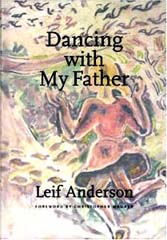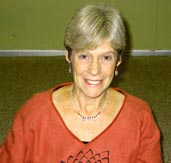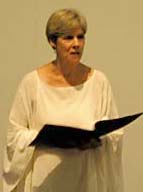Major Works
- Dancing with My Father (University Press of Mississippi, March, 2005)
- Dancing through Airth (Airth Publications, 1986)
Biography
Biography of Leif Anderson
Mississippi writer, dancer, and artist Leif Anderson is the third child of Mississippi’s best known artist Walter Inglis Anderson and his wife Agnes Grinstead Anderson.
Her father died in 1965, but his work is becoming better known every year. Today he is known for being a prolific artist in many mediums. However, to do his now famous work, Walter Anderson left his family and lived alone. He could not deal with the distractions and commitments of daily family life.
To Leif, he was an absent father. In her memoir Dancing with My Father, which is a series of vignettes, she writes poetically about her struggle to come to terms with Walter Anderson, the father/artist.
 Leif Anderson was born in 1944 at Oldfields, her mother’s family home in Gautier, Mississippi. She and her three siblings Mary, Billy, and John grew up with their mother in a house which was once a barn at Shearwater. The name Leif was given to her by her father because Leif Ericsson, a Viking explorer, was a favorite. He thought she would be a boy, but it didn’t matter to him when she wasn’t. He still wanted to call her Leif.
Leif Anderson was born in 1944 at Oldfields, her mother’s family home in Gautier, Mississippi. She and her three siblings Mary, Billy, and John grew up with their mother in a house which was once a barn at Shearwater. The name Leif was given to her by her father because Leif Ericsson, a Viking explorer, was a favorite. He thought she would be a boy, but it didn’t matter to him when she wasn’t. He still wanted to call her Leif.
When she was about three, Walter Anderson became an absent father as he moved himself to Shearwater in Ocean Springs, Mississippi, to devote himself to art and nature. The effect that decision had on Leif continues to affect her.
Leif Anderson is a dancer who studied ballet with Lelia Haller in New Orleans, where she became a member of The Crescent City Ballet. She danced with the New Orleans Opera as well and has performed and taught workshops in Massachusetts, New York, and throughout the South.
On November 15, 1965, Leif Anderson’s daughter Moira was born. On November 30, 1965, Leif’s father, Walter Anderson, died of complications from lung cancer. Leif also has a son named Vanja, who now lives in the house where Walter Anderson secluded himself to paint.
Leif Anderson’s life has been spent as a dancer, artist, sister, daughter, mother and wife and now she is also a writer. She seems to finally have accepted her life as the daughter of the troubled Walter Anderson and gone beyond to Leif Anderson, the creative person in her own right.
E-mail Interview with Leif Anderson
November 2005
Could you please give us some additional biographical information? We know about your parents and siblings, but could you tell us about your children (and their father) and do you have any grandchildren?
Moira (daughter) was born in 1965, two weeks before my father died. Her father was an artist and a very fine art teacher at the school where I was modeling in New Orleans. I chose to have her and received the gift of her beauty, humor, grace, and companionship. She is now an amazing Yoga teacher and mother to Olivia and Wyatt (my grandchildren). Her husband, Billy, is a lawyer and a very good daddy. Ivan (Vanja), my son, was born in 1972. I was married to his father, Mischa Philippoff, a 6 ft., 8 in. tall Russian, whose career was in graphic design. Vanja has charmed me from the moment he was born. He is handsome, funny, and very very wise. He teaches English in a Biloxi Junior High School and is married to Christy, who is also a teacher. I have two grandpups, Ocean and Mahi.
Do you remember how you felt about your father when you were a teenager?
I felt kind of nervous in his company. He seemed like a familiar stranger, but I knew he was my daddy and every little special attention meant a lot to me. I think I admired his art, but his strange behavior over-shadowed that. My peers thought he was weird, and their remarks embarrassed me.
What is your happiest memory that you remember with your father?
Probably the time he kissed my hand and called me “tres belle” (very beautiful). This was in passing. He never lived with us again after I was two and a half years old. I’m sure I was often a happy baby before he left.
Are you willing to discuss the worst memory with your father, and if so, would you describe it?
My father sometimes drank too much wine and could be violent. It was very frightening. The worst though, I think, was when he was hurting and asking for help and someone he loved was threatening him.
When did you begin dancing lessons? What has dancing meant to you other than as a professional career? Would you say that dancing is a form of escape for you as well as a career and a pleasure?
I began dancing lessons when I was about four, mostly because of a deformed foot. My mother’s idea. I had loved to dance freely, and she knew I had talent. From then on she cultivated the gift. Sometimes I was shy and awkward in class, but it came to be my dream. It got bigger and bigger, crowding out other gifts, like writing. I studied Ballet in New Orleans instead of going to college.
Eventually I felt stifled by traditional forms of dance, and returned to freer ways. Improvisation allowed me to realize spiritual depths in myself. Through dance, I have known ecstasy that I could hardly describe. And performing, I have communed with others as I couldn’t in other situations. In 1977, I discovered a technique that I called Airth, based on natural laws; this I could teach and did for many years. I have often thought that I might be escaping into dance, but I have also used it to tell my story. Of course not everyone knows what I’m telling when I dance. Perhaps as I have matured, I am less inclined to escape from the life I have lived. In writing I can be more clear in what I am telling, and the dancing is only part of the telling.
What tangible object do you have from or of your father’s that you treasure the most and why is that? Do you have any of his paintings or drawings in your home?
Probably the vase that he painted when I was born. He went home from seeing me at the hospital and affirmed my coming by painting me on the vase twice. He gave me wings. I also have paintings. I love the Resurrection Rabbit watercolor, and an oil of a ghost crab on Horn Island in the moonlight. I treasure a book he gave me called THE ADVENTURES OF THE BLACK GIRL IN HER SEARCH FOR GOD by Bernard Shaw.
Your book DANCING WITH MY FATHER is marvelously written. How much revision did you have to do for each vignette before it was published?
Really, hardly any. Maybe one quick refining. I did have punctuation corrections to do after my editor saw it.
Are you working on another book? If so, will it also be about your father and you, or do you have plans for other themes or stories?
I have three other books in the works. One is autobiographical, but not focused specifically on my father. One is about my attraction to Paris, France, and my experiences there.
The other is a novel.My current project is a children’s book, but not just for children. A small blue rocking chair is the main character, and she is not content to rock back and forth like the other chairs.
Her quest is for infinite motion, like the sky. And her mentor is a very wise tree. I intend to illustrate it with watercolors.
Did you already have many completed drawings of your own to choose from or did you do the drawings in your book specifically for that purpose?
I have many completed drawings, mostly of dance. For the book I had to start from scratch, be inspired by each vignette. I did many drawings for some of the pieces before I was satisfied. It was great fun.
What has living in Mississippi meant to you?
I am very attached to my home, appreciate its unique qualities, love its laid back aspect. But I have lived in many other places, including New York City. The other places did not hold tight to my heart, but I found great freedom for growing and becoming. Ideally one sinks one’s roots in the trusted homeland and travels out to explore and expand one’s boundaries. The best of both worlds?
What advice would you have for teenagers today?
Respect your upbringing, whatever it consists of, but believe in yourself. Listen to the small true voice inside more than to the voices of peers and authority figures. Dream and explore. Laugh and cry without shame. Keep a journal!
Related Websites
- Information about Leif’s famous father Walter Anderson here.
- A Dance of Balance posts by Leif Anderson.
- Information about Leif Anderson and her art on Brown’s Fine Art Gallery Site.
- Leif Anderson appears at Mississippi State University.
- Book information on University Press of Mississippi about Dancing with My Father.
- Plans for Anderson family visit to MSU gallery postponed by Katrina damage to their father’s work.


